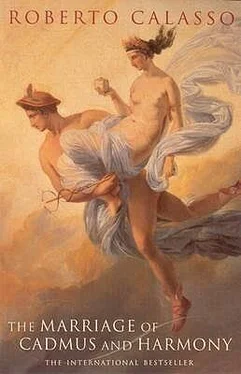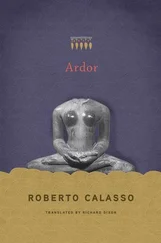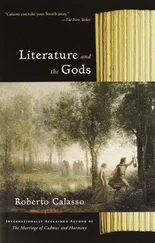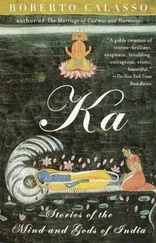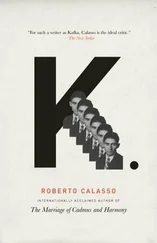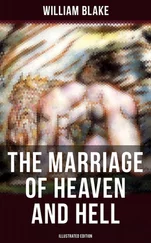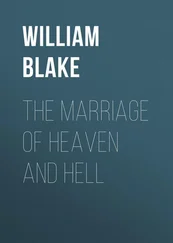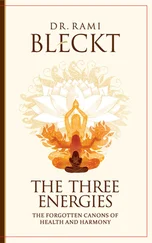There was a time when hierogamy and sacrifice were the same thing. In the course of history, this unnameable unity gradually split into two. In the beginning, the primordial god would copulate and kill himself at the same time. Men recalling this feat could hardly emulate it if they wanted to survive and were thus forced to divide it into two phases: killing and copulation, sacrifice and marriage. But the flavor of marriage lingers on in the sacrifice, just as the flavor of the sacrifice lingers on in marriage. A tangible object unites the two events: the crown. One is crowned whether going to the altar as a victim or going as a bride. And the ambiguity of that crown is the constant, never articulated heart of tragedy: the misunderstandings, recognitions, and double meanings that tense the tragic nerve all derive from the primordial double meaning contained within the crown.
It would be ingenuous to suppose that only the moderns have been able to appreciate all this, as if in classical tragedy it had always remained implicit and unconscious. On the contrary, this notion seems to have formed the canonical background underlying tragedy. Otherwise, to quote just one example, why would Euripides’ chorus in Iphigenia in Aulis move so abruptly from the evocation of Peleus and Thetis’s marriage, at which the gods are among the guests, to the description of Iphigenia as a “spotted heifer” from whose “mortal throat blood will be made to flow” in Aulis, where her father claims to be bringing her to her marriage. That truncated passage, split into two dismembered parts, marriage and sacrifice, is, as Euripides saw it, one single speech: and we pass from one part to the other of necessity, because they belong together. In the same way, the ancient texts make perfectly clear that the tension of tragedy is the tension between murder and sacrifice, the crushing of the one against the other or, alternatively, the splitting apart of the two terms. In fact, all the surviving tragedies could be classified according to the angle of impact between murder and sacrifice or according to the varying densities of ambiguity in the way the two phenomena are presented. In Iphigenia in Aulis we are hammered time after time with the verb kteínein , “to kill,” while thúein , “to sacrifice,” is used only rarely, the distance between the two being spanned by spházein , “to slit a throat.” Yet the plot to this tragedy hinges on a sacrifice, not a murder. Whereas Agamemnon , which tells the story of a murder, is saturated in the terminology of sacrifice.
When Iphigenia agrees to her own sacrifice, agrees, as she puts it, “to this wicked spilling of blood by a wicked father,” because “the whole of Greece is looking to her” and her death will allow “the Greeks to reign over the barbarians rather than the barbarians over the Greeks,” for “the barbarians stand for slavery, the Greeks for freedom”—when a speech like this pours rapidly, confidently, from the mouth of the virgin of Mycenae, it’s clear that any cosmic vision of sacrifice has already foundered. Sacrifice here no longer has to do with the equilibrium between gods and men but between men and other men, between “the kings of men” and that dangerous multitude milling around the tents.
But here comes the outrageous enigma: man now discovers that sacrifice is just as effective as a tool of social manipulation as it was to appease the gods. Any cosmic tension evaporates. What we’re left with is an unsuspecting girl whose throat is to be cut before an army mad with the lust to be setting sail for an almighty bloodletting (it’s Aphrodite, not Ares, who’s goading them on). And that killing turns out to be very useful. It is the first pro patria mori , and it stands apart from all the others and dwarfs them, just as Pericles’ speech on democracy dwarfs thousands of later speeches on the subject. Even before the Achaeans hoisted their sails for Troy, Iphigenia’s body had been used as the medium for a radical secularization of the practice of sacrifice. The gods were still there, intact, but man’s relationship with them was now taking on the same spareness and pathos as that between daughter and father, servant and master, lover and beloved, husband and wife. The only thing that separated heaven and earth now was an immense inequality in terms of power. Not an inequality of mind, or heart, or ceremony at all. With all the cosmic scaffolding that had stood between gods and men having thus collapsed, life seemed the more buoyant and resplendent, but lonely too, fleeting and irretrievable. Such is the dominant sentiment that runs through the lucid age of Greece from Homer to Euripides. Everything is reduced to a few simple elements that can be reduced no further. Life is no longer a series of trade-offs between invisible powers but “the sweetness of looking at the light.” Thus speaks the philopsychía in Iphigenia, that last “clutching at life.” And her conclusion is brusque: “To look into the light is the sweetest thing for a mortal; what lies beneath the earth is nothingness.”
This brazen speech, the daring claim that the whole world of spirits is “nothingness,” points to the affinity that predestined the girl to be Achilles’ bride. For the defiant words she hurls at Agamemnon as she is about to die prefigure Achilles’ answer to Odysseus in the underworld, his scorn for any vain sovereignty over the dead and his heartrending desire for a part, however miserable, in the life above.
The whole classical world, from the Minoan frescoes to the Roman banquets, is strewn with leafy crowns. To be a coronarius in Rome was to have a profitable business, since crowns were used on all kinds of occasions. “In the olden times,” Pliny recalls, “crowns were used to show respect for the gods and the Lares, public and private, the tombs and the Manes.” Then there were crowns for the statues of the gods, for sacrificial victims, and for brides and bridegrooms. Crowns for the winning athletes at the games. Crowns for poets and soldiers who excelled. Crowns worn for fun at banquets. Lovers would hang crowns on their beloveds’ doors. And Cleopatra even had the idea of poisoning Antony with the petals of a crown. From the Egyptian mummies to the Christian polemicists, who tried to avoid this pagan usage but lapsed back into it just the same, you could say that the Mediterranean world lived and moved for centuries within that circular image, those symbolic but ephemeral flowers, different for every occasion. Such was the ubiquitousness of the crown that a whole literature sprang up around it. Few other subjects seemed so well suited to contests of erudition between sophists at banquets. But, if we look behind their relaxed chatter to the origin of the crown, what do we find?
The first crown was a gift from Zeus to Prometheus. It thus came from the gods as homage to a man whose relationship with them was anything but clear, at once a threat and a means of salvation. The crown in fact was supposed to compensate for the fetters in which Zeus himself had long imprisoned Prometheus. The cold grip of the metal was thus transformed into what Aeschylus calls “the best of all fetters”: a circular weave of leaves, twigs, and flowers. It was the same process by which Aphrodite’s many-colored girdle had come to be superimposed over Ate’s suffocating net. And, just as deceit was woven into Aphrodite’s girdle, in the crown of Prometheus we can see deceit throwing down its ultimate challenge. Hyginus writes: “ Nonnulli etiam coronam habuisse dixerunt, ut se victorem impune peccasse diceret ”: “Some say that [Prometheus] got hold of a crown, so that he could claim to have triumphed, unpunished for his crime.” Like the girdle of Aphrodite, Prometheus’s crown is the fetter of necessity. Except that now, dispersed in petals and transformed by beauty, that fetter approaches the delicate superfluousness of ornament. The veil of aesthetic appearance can conceal beneath it even the gamble of the man who attempts to elude necessity, the man who still seeks an impunity anánkē does not concede. Or so Hyginus insinuates.
Читать дальше
